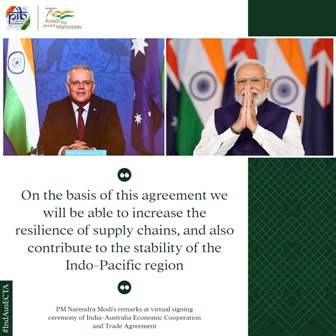India and Australia Free Trade Pact: A Win-Win for Both Nations
India-Australia Economic Cooperation and Trade Agreement signed into force: A Boost for Bilateral Trade and Job Creation.
The Government of India has achieved the rare distinction of operationalizing two Trade Agreements this year—the India-UAE FTA and the India-Australia ECTA.
this year—the India-UAE FTA and the India-Australia ECTA.
India and Australia have recently entered into a new Economic Cooperation and Trade Agreement (ECTA). The Ind-Aus ECTA was signed on April 2, 2022, and after its ratification and exchange of written instruments, the agreement came into force on December 29, 2022.
Australia largely exports raw materials to India, while India exports finished goods, making their trade relationships complementary to one another. This complementarity is further strengthened by the Ind-Aus ECTA. Rajesh Agrawal, the Additional Secretary of the Department of Commerce and Industry, said in a statement, “The Ind-Aus ECTA brings together two major economies of the world: India, the 5th largest economy, and Australia, the 14th largest economy.” “The trade between the two countries is highly complementary, offering opportunities on both sides and paving the way for a win-win solution for both India and Australia.”
Currently, India’s imports from Australia amount to 17 billion US dollars, while India’s exports to Australia amount to 10.5 billion US dollars. India’s imports from Australia are primarily raw materials and intermediate goods, with coal making up 74% of Australia’s exports to India. On the other hand, India’s exports to Australia are broad-based and dominated by finished goods and consumer products. India also spends about $4 billion US each year to send students to school in Australia.
Benefits of Trade in Goods
Under the Ind-Aus ECTA, Indian goods will have zero customs duty access to the Australian market.
All tariff lines will allow Indian products to enter the Australian market duty-free. The Agreement will help a number of labour-intensive Indian industries that are currently subject to an Australian import charge of 5%. The deal will result in immediate duty-free access to 98.3% of the tariff lines, or 96.4% of India’s value-added exports to Australia. Over a five-year period, the remaining 1.7% of the lines will become zero-duty lines. Australia offers duty-free status across all of its tariff lines.
Faster approval of medicines and more affordable raw materials
All labour-intensive industries, including textiles and apparel, agricultural and fish products, leather goods, footwear, furniture, numerous engineering goods, jewellery, and some pharmaceuticals, are covered by immediate duty-free entry. As a result, many businesses will be able to compete by obtaining cheaper raw materials, including those in steel, aluminium, clothing, and other sectors. A separate Annex on Pharmaceutical Products has also been agreed to by both parties, allowing for the fast-track approval of proprietary, generic, and biosimilar medications.
90% of Australian exports, measured by value, are duty-free in India.
India is granting duty-free access to 90% of Australian products’ value (including coal). Zero duty on goods worth 85.3% will be offered right away, while goods worth 3.67% will be provided gradually over the course of 3, 5, and 10 years. Coking coal and thermal coal, wines, seven agricultural items with TRQ (cotton, almonds shelled and in shell, mandarins, oranges, lentils, and pears), metals (aluminium, copper, nickel, iron, and steel), and minerals are just a few of the tariff categories that India has provided Australia concessions on (manganese ore, calcined alumina). Numerous delicate products, including wheat, sugar, iron ore, apples, walnuts, and other foodstuffs, have been kept on India’s exclusion list.
Free access could create 10 million jobs in India and increase exports from India to Australia by $10 billion over the next five years.
The Ind-Aus ECTA covers trade in goods and services, rules of origin, technical barriers to trade, customs procedures, trade remedies, legal and institutional issues, and the movement of natural persons. The agreement will also provide cheaper raw materials, faster approval for medicines, and zero-duty access to 90% of Australian exports to the Indian market.
Australia’s pledges under the Trade in Services are the best it has made thus far in trade agreements and are consistent with its most recent FTA with the UK. Australia has made extensive commitments in about 135 sub-sectors, committed its schedule to the negative list, and been granted Most Favoured Nation (MFN) designation in about 120 sub-sectors. The Agreement establishes a 1,800-person annual quota for Indian chefs and yoga instructors. For Indian students, a post-study work visa (18 months to 4 years) would be made accessible. More than 1 lakh Indian students will benefit from the post-study employment visa in Australia. The #IndAusECTA arranges for young professionals to obtain work and holiday visas.
After five years after the Agreement’s entry into force, India has finally agreed to a negative listing. What, however, is “negative listing? According to the negative listing strategy, a nation treats locally produced and imported goods and services equally in all respects, with the exclusions being stated in the negative list. Therefore, after a period of five years, India would treat services exported from Australia in this manner.
India is also committing to Australia in about 103 service sub-sectors, with Most Favoured Nation status being granted for the first time in about 31 service sub-sectors. Australia receives promises in the areas of business services, insurance, banking, and other financial services. The Agreement opens up opportunities for investment in telecom, building, health, and environmental services, as well as computer-related services. These are all comparable to earlier FTAs that India has signed.
Additionally, commitments have been made to obtain Mutual Recognition Agreements (MRAs) for professional services within the next 12 months.
The Ind-Aus ECTA will not only benefit India and Australia but also have a positive impact on the world. The agreement will strengthen the complementary trade relationship between the two countries and create numerous opportunities for growth and development.
